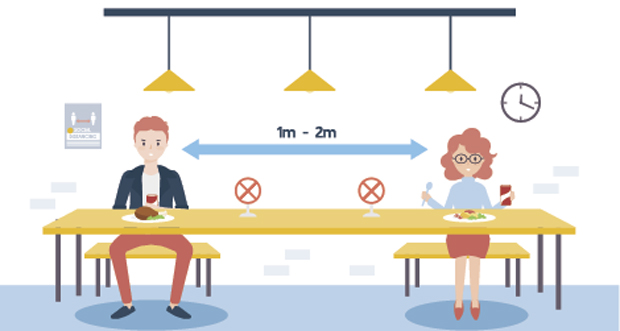With the gradual return of staff to the workplace, in-house catering facilities which have been on hiatus during the lockdown can begin to ramp back up. But with the situation still being far from normal, how can caterers and their FM clients find ways to deliver food and beverages while adhering to social distancing measures?
 THE CATERING DESIGN EXPERT’S VIEW
THE CATERING DESIGN EXPERT’S VIEW
STEVE HUTCHINGS,
DIRECTOR AT CATERING DESIGN GROUP (CDG)
The workplace dining experience as we know is set to change dramatically. Every catering operation will have to adapt to this new norm, and while it may seem daunting, there are steps that all catering operators and their FM clients can take to ensure a safe and comfortable environment.
Regardless of the size and scale of a catering facility, the first thing is to scrutinise every aspect of a catering facility, from the design, layout and operational requirements to staffing, logistics and the use of technology to help reduce the risk of contamination.
This isn’t just about removing some tables and chairs to manage social distancing. Take front of house, for example. Consider a redesign of the layout to improve customer flow and social distancing compliance. Touch points like salad bars, deli-bars, buffets and beverage service stations that require customers to serve themselves must be reviewed and alternative service styles considered, such as increased grab ‘n’ go. Removing specific serving points has the potential to create additional space for people to social distance. However, the downside is the demise of a much-loved self-service feature so it’s important to reassess menus to ensure they are meeting customers’ expectations. Introducing assisted service and new collection points and delivery options will add to the eating experience.
Design elements such as directional signage and graphics on walls and floors will be essential to control traffic and aid customer flow. Staff restaurants and other catering facilities will also have to factor in increased hygiene points like touchless sanitisers and protective screening. The availability of technology for contactless ordering, payment and collection is now essential.
Mindful of how long the COVID-19 virus remains on different surfaces, this is a good time to consider investing in different materials such as anti-bacterial wall cladding, anti-microbial upholstery for seating areas and anti-bacterial touch screen technology.
What goes on back of house will be equally important. For example, the rezoning and the reorientation of areas such as kitchen workstations to reduce the risk of cross-infection is essential. Assess your kitchen equipment to see if it is fit for purpose and what works may have to be done to change the position of big items like dishwaters and ovens.
Re-examining shift patterns is also important to ensure minimal cross-over of staff. Staggering start, end and break times is one way of tackling this issue. Review storage and waste facilities/capacity and think about the risk points in your deliveries process.
Outdoor spaces will take on a whole new world of possibilities to add to the workplace eating experience while keeping people safe. As always, this is budget dependent, but there are things to make an outdoor space attractive and safe without a massive investment, such as the use of a temporary structure like a marquee or portacabin.
There has to be a complex rethinking of an entire catering facility to make it a safe space for all but maintaining ambience and the dining experience is also important as this is vital for staff wellbeing and morale.
 THE CONTRACT CATERER’S VIEW
THE CONTRACT CATERER’S VIEW
IAN THOMAS,
CEO, BARTLETT MITCHELL
Firstly, like many other contract caterers we also have a portion of our operations remaining open (over 15 per cent) during this time across a wide variety of sectors. The common theme across these sites has been the straightforward implementation of new COVID Secure processes and how quickly teams and customers have adapted.
From the moment lockdown started we, like others, switched to planning phase and learning and sharing with others. The collaborative process has helped drive an extremely robust re-mobilisation plan and new processes that match or exceed existing Government guidance.
Central to the next phase is confidence, whether it’s for our teams through training and daily Health Declaration Surveys; our clients through advice on safe operating procedures; or our customers who want social distancing and hygiene factors to be overtly visible. All of these are available now and being used successfully.
Obvious physical measures including; ‘sneeze screens’, floor markings, removal of all self-serve offers, ‘Chequer Board Seating’ and single directional flows have already been long planned with overtly visible and robust cleaning regimes in both front and back of house areas.
Social distancing is not an ideal measure given that many clients have spent years moving to maximising occupancy per square metre, however, we have the tools in place to safely manage this. Following the government’s announcement that social distancing is to be reduced to one metre, this will enable swifter progression to wider building occupancy and businesses to progress to the next normal.
Workplace dining will still be a very important requirement for the majority of our clients. Food is seen as social glue for company culture which is vital as offices open. Some argue it may be recognised as the primary benefit to drive productivity and engagement.
The food and beverage offer as lockdown lifts will undoubtedly change. There will be fewer people in buildings during the early phases and as businesses adopt more flexible work patterns. Initial demand is likely to be for a simple Grab and Go offer. However, we are also finding that clients are asking about food that combines comfort and health, followed by a desire for menus that excite and contrast home cooking. Longer term we believe that we will see the percentage of people using the catering in a workplace will increase, particularly as use of an uncontrolled high street will likely to be discouraged.
We are fully prepared for changes to service options, with an all-day service with longer operating hours, or seven-day working. We believe that people will still want great food and drink with great service and will have missed this during the lockdown. In most cases, our workplace dining will be the first meals outside of the home for three months so our teams want to make this an excellent experience.
Technology is already the backbone of how we operate; so our new pre-order and pre-pay app, enables; cashless, click & collect, delivery and pre-booking visit slots to our restaurants which are all true enablers of social distancing management.
Many of our clients have indicated they will recommend employees minimise journeys out of the building once they have arrived for the day. They will also rely heavily on their facilities and catering teams to deliver safe, clean and hygienic environments. It is our belief that the high street will have a challenge with maintaining social distancing measures in their outlets and there will be considerable queuing congestion on the pavements where there are a number of outlets in close proximity.
Our sector is built on an agile foundation and, increasingly so in recent years, we have had to conform to all manner of legislation to enable us to function within other peoples’ buildings. Flexibility as a business is going to be invaluable as we navigate our way through this.





